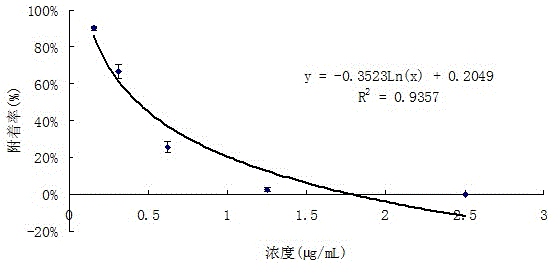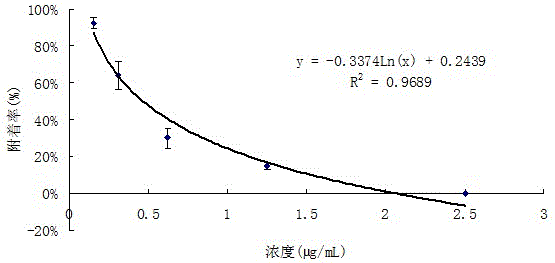Application of flavane compound in preventing marine biofouling
A technology of marine organisms and compounds, applied in the fields of chemicals for biological control, pest control, paints containing biocides, etc., can solve problems such as pollution, difficulty in using marine antifouling coatings, and low efficiency, and achieve technological Mature, strong anti-biofouling activity, high safety effect
- Summary
- Abstract
- Description
- Claims
- Application Information
AI Technical Summary
Problems solved by technology
Method used
Image
Examples
preparation example Construction
[0056] The present invention also provides a preparation method of the above-mentioned flavan compounds. The method comprises the preparation of said compound from a plant of the genus Cubelia, such as Cauliflower. Preferably, the flavanoids are prepared from the roots, stems, leaves, fruits of the Potato plant. Preferably, the method has the steps of:
[0057] (1) Grinding the dried leaves of the wild bean to obtain fragments of the leaves of the wild bean;
[0058] (2) Soak the fragments of wild passion bean leaves in a solvent to obtain an extract;
[0059] (3) Filter the extract and concentrate under reduced pressure to obtain the extract;
[0060] (4) Disperse the extract in water, sequentially extract with petroleum ether, ethyl acetate and n-butanol, and after the extract is drained, obtain petroleum ether extract, ethyl acetate extract, and n-butanol respectively. Butanol extract part of the extract;
[0061] (5) Part of the extract extracted with ethyl acetate wa...
Embodiment 1
[0069] Example 1 Inhibitory activity of the plant extract of wild pea to the attachment of barnacle larvae
[0070] Source of material: Wild beans were collected in Kaiyuan, Yunnan, and identified as Uraria clarkei (Clarke) Gagnep. The specimen is preserved in the Herbarium of the College of Chemistry and Biochemistry, Yunnan University for Nationalities.
[0071] The preparation of the wild passion bean extract: the dried wild passion bean leaves are crushed to obtain the leaf fragments of the wild passion bean respectively; then the fragments of the wild passion bean leaves are extracted 3 times with 95 volume % ethanol / water reflux, each time The extract was obtained in 2 hours; the wild bean extract was filtered separately and concentrated under reduced pressure with a rotary evaporator to obtain an extract for later use.
[0072] Using an experimental model of inhibition of barnacle Venus larvae attachment (see scientific literature: Xu Y., He H. P., Qian P. Y, et al....
Embodiment 2
[0074] Example 2 Further experimentation with wild pea
[0075] Further experiments were carried out with wild passion bean plants. This is not to imply that other plants of the Bean genus are not active.
[0076] Respectively use 70% acetone / water, 95% ethanol / water and 90% methanol / water as extraction solvents by volume percentage, and repeat Example 1. The results are shown in Table 2. The experimental results show that the 70% acetone extract of wild passion bean leaves and the 95% ethanol extract of wild passion bean leaves obtained by using 70% acetone / water, 95% ethanol / water and 90% methanol / water as extraction solvents respectively It has the same significant anti-biofouling activity as the 90% methanol extract of wild pineapple leaves, so the anti-biofouling activity in wild pineapple can also be obtained by using different concentrations of acetone / water or ethanol / water or methanol / water as extraction solvents. damage the active ingredient.
[0077]
PUM
| Property | Measurement | Unit |
|---|---|---|
| Particle size | aaaaa | aaaaa |
Abstract
Description
Claims
Application Information
 Login to View More
Login to View More - R&D
- Intellectual Property
- Life Sciences
- Materials
- Tech Scout
- Unparalleled Data Quality
- Higher Quality Content
- 60% Fewer Hallucinations
Browse by: Latest US Patents, China's latest patents, Technical Efficacy Thesaurus, Application Domain, Technology Topic, Popular Technical Reports.
© 2025 PatSnap. All rights reserved.Legal|Privacy policy|Modern Slavery Act Transparency Statement|Sitemap|About US| Contact US: help@patsnap.com



